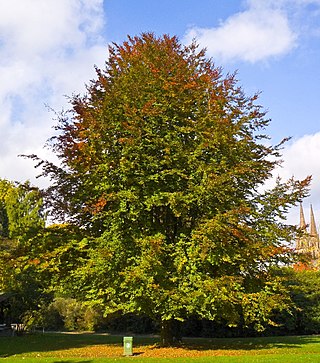
The Fagaceae are a family of flowering plants that includes beeches, chestnuts and oaks, and comprises eight genera with about 927 species. Fagaceae in temperate regions are mostly deciduous, whereas in the tropics, many species occur as evergreen trees and shrubs. They are characterized by alternate simple leaves with pinnate venation, unisexual flowers in the form of catkins, and fruit in the form of cup-like (cupule) nuts. Their leaves are often lobed, and both petioles and stipules are generally present. Their fruits lack endosperm and lie in a scaly or spiny husk that may or may not enclose the entire nut, which may consist of one to seven seeds. In the oaks, genus Quercus, the fruit is a non-valved nut called an acorn. The husk of the acorn in most oaks only forms a cup in which the nut sits. Other members of the family have fully enclosed nuts. Fagaceae is one of the most ecologically important woody plant families in the Northern Hemisphere, as oaks form the backbone of temperate forest in North America, Europe, and Asia, and are one of the most significant sources of wildlife food.
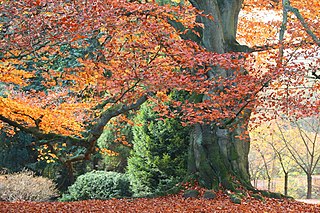
Beech (Fagus) is a genus of deciduous trees in the family Fagaceae, native to temperate Eurasia and North America. There are 13 accepted species in two distinct subgenera, Engleriana and Fagus. The subgenus Engleriana is found only in East Asia, distinctive for its low branches, often made up of several major trunks with yellowish bark. The better known Fagus subgenus beeches are native to Europe and North America. They are high-branching trees with tall, stout trunks and smooth silver-grey bark. The European beech Fagus sylvatica is the most commonly cultivated species, yielding a utility timber used for furniture construction, flooring and engineering purposes, in plywood, and household items. The timber can be used to build homes. Beechwood makes excellent firewood. Slats of washed beech wood are spread around the bottom of fermentation tanks for Budweiser beer. Beech logs are burned to dry the malt used in some German smoked beers. Beech is also used to smoke Westphalian ham, andouille sausage, and some cheeses.

Fagus sylvatica, the European beech or common beech is a large, graceful deciduous tree in the beech family with smooth silvery-gray bark, large leaf area, and a short trunk with low branches.

Fagus orientalis, commonly known as the Oriental beech, is a deciduous tree in the beech family Fagaceae. It is native to Eurasia, in Eastern Europe and Western Asia.
This article gives an overview of the woodland and scrub communities in the British National Vegetation Classification system.

The New Canaan Nature Center is a botanical garden, arboretum and nature preserve located at 144 Oenoke Ridge, Route 124, about .25 miles (0.40 km) north of the center of New Canaan, Connecticut.

Phytophthora × cambivora is a plant pathogen that causes ink disease in European chestnut trees. Ink disease, also caused by Phytophthora cinnamomi, is thought to have been present in Europe since the 18th century, and causes chestnut trees to wilt and die; major epidemics occurred during the 19th and 20th centuries. P. cinnamomi and P. × cambivora are now present throughout Europe since the 1990s. Ink disease has resurged, often causing high mortality of trees, particularly in Portugal, Italy, and France. It has also been isolated from a number of different species since the 1990s, including:

Abraxas sylvata, the clouded magpie, is a Palearctic moth of the family Geometridae that was named by Giovanni Antonio Scopoli in 1763.

Nematopogon adansoniella is a moth of the family Adelidae. It is found in Europe.

Cydia fagiglandana, the beech moth, is a moth of the family Tortricidae.
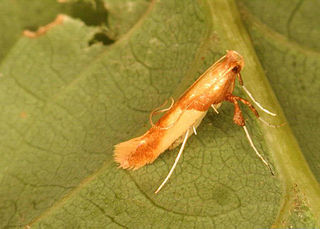
Caloptilia alchimiella is a moth of the family Gracillariidae. It is found in Europe and the Near East.

The weeping beech, Fagus sylvatica 'Pendula', is a cultivar of the deciduous European beech. The original tree was found in the grounds of an English park, and it has been propagated by grafting, then many distributed widely.
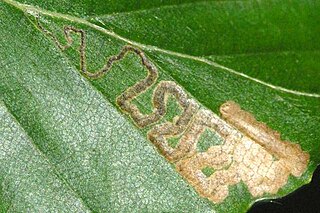
Stigmella tityrella is a moth of the family Nepticulidae. It is found in all of Europe, except the European part of Russia.
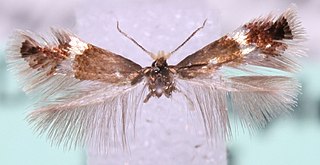
Stigmella hemargyrella is a moth of the family Nepticulidae. It is found in most of Europe, except Iceland, Norway, Finland, Portugal and most of the Baltic region.

Caloptilia robustella is a moth of the family Gracillariidae. It is known from all of Europe, except the Balkan Peninsula.
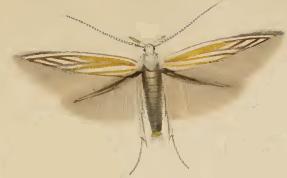
Coleophora currucipennella is a moth of the family Coleophoridae found in Europe. It was first described by Philipp Christoph Zeller in 1839.

Fagus × taurica, the Crimean beech, is a deciduous tree in the beech genus Fagus.
A Fau de Verzy is either a Dwarf Beech, a dwarf oak tree, or a dwarf chestnut tree. These grow in the forest of Verzy, 25 km south of Reims in France. In this forest are less than a thousand dwarf beeches, some dozen dwarf oaks and some dwarf chestnuts, but this article speaks in the main about dwarf beeches.

Ideain, the cyanidin 3-O-galactoside, is an anthocyanin, a type of plant pigment.


















